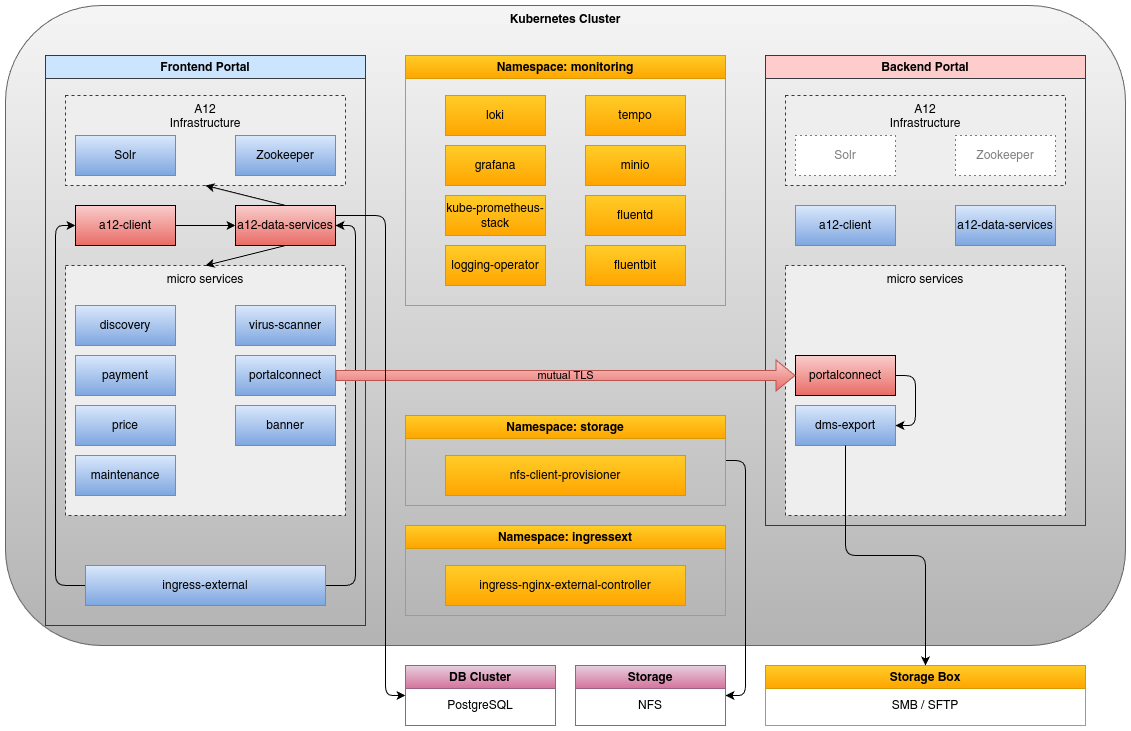For more than 100,000 members, the new OZG application portal of the chambers of tax consultants provides 24 services centrally around the clock. In order to be fail-safe, easy to maintain and flexibly expandable, the portal relies on a microservice architecture and operation in a Kubernetes cluster. We take a look at the technical implementation of the software, which was developed using the enterprise low-code platform A12.
Since 19 September 2023, the application portal of the chambers of tax advisors (StBK) has provided standardized digital services for members in all 16 federal states of Germany in one central location. They are sorted into five areas: tax consultant examination, training, appointment and waiver, professional practice companies and other applications in accordance with the German Steuerberatungsgesetz (StBerG). The OZG project was implemented in just 14 months under the leadership of the Nuremberg and Munich chambers of tax consultants in collaboration with mgm.
“The deadline of the OZG was key to the rapid implementation of the portal. Thanks to the close cooperation between the chambers, we were able to create a joint offering that now makes it much easier for our members to submit applications,” explains Moritz Alt, Managing Director of the Nuremberg Chamber of Tax Consultants, which is in charge of the project. “At the same time, we have created the basis for a more comprehensive modernization of our IT. We are gradually driving forward the cloud transformation of our systems in order to further improve the service for our members and reduce internal costs.”
Modeled forms, validation rules and print templates
The individual software project was implemented on the basis of the Enterprise Low Code Platform A12. The domain-specific content – i.e. the forms for the 24 services, including the underlying data models and validation and calculation rules – was defined using the A12 modeling tools. This reduced the development effort right from the start and future technical changes can also be implemented quickly by adapting the respective models. The modeling approach was also used to design the PDFs generated from the application data.
Within the overall project, the models are stored in a separate repository and are provided as artifacts. As changes to the models tend to occur infrequently from a technical point of view, mgm takes over their maintenance and updating as a service provider. In the case of regular and frequent changes, however, it is always advisable to involve those responsible in the modeling of the content. In the tax environment, for example, a process has been established in which the respective specialist departments use the A12 modeling tools to update the changes themselves, taking into account the latest changes in tax legislation.
Updating microservices with zero downtime
While the domain-specific content was modeled, the technical implementation of the StBK application portal focused on developing a robust and future-proof portal infrastructure. By using the A12 Project Template, a range of basic functionalities, a proven tech stack and a secure configuration were in place right from the start. Building on this, a microservice architecture was developed that encapsulates key functionalities of the application portal, such as the payment service, and ensures efficient operation.
“Thanks to the architecture developed, we are able to carry out zero-downtime updates,” explains Guido Wischrop, who was responsible for technical project management at mgm. “For example, if the price of a service changes, we can update the payment service while it is running. Kubernetes keeps the old instance alive until the new instance is available and can be used.” To ensure the system is fail-safe, each service also runs at least twice.
Integration of two identity providers and a payment provider
Before portal users can submit an application, they have to register. During the course of the project, the development team integrated two SAML Identity Providers (IDP) using the A12 component User Management, Authentication & Authorization (UAA):
- BundID enables a broad public to use the portal’s services. After registering via BundID, it is possible, for example, to apply for admission to the tax consultant examination.
- The tax consultant platform offers a verified tax consultant identity. This is the prerequisite for submitting applications that are only accessible to professionals listed in the tax advisor directory.
A processing fee is payable for several services provided by the chambers of tax advisors. A payment provider has been integrated in order to process payments directly via the new portal. The GiroCheckout process from financial services provider S-Public Services was chosen. “The payment API was well documented and easy to integrate. Nevertheless, a great deal of care was required. You also have to consider special cases – for example: What happens if the payment provider is unavailable? Or if a connection problem occurs after the payment?” says Guido Wischrop.
Automated routing of applications to the right chamber
A special feature of the portal is the automated delivery of completed applications to the correct chamber and the person responsible for processing them. A specially developed discovery service is responsible for this mechanism. It uses parameters such as place of residence and workplace to determine which chamber and department is responsible for the respective request. If the responsibility cannot be clearly determined, a dialog opens as a fallback solution in which the user can manually select the chamber.
In the future, the application data can be transferred directly in a structured form to the downstream systems of the respective chamber. An API for this has already been implemented. However, as the processing systems are not yet standardized and are currently being modernized, a storage box concept for data transfer was implemented first: The application portal exports the application data as a PDF and stores it in the directories of a storage box, which are synchronized with the document management systems in the processing department via a secure channel using the Samba protocol or Secure File Transfer Protocol.
Modular structure enables expansion with additional functionalities
In the version of the tax consultant portal that has gone into production, a large part of the functionality developed is on the front-end side. So far, the backend has basically only been there to receive the applications received and forward them correctly. However, in addition to this basic transport mechanism, further features relating to communication between chamber members and clerks can be implemented in the future.
“The launch of the application portal was an important milestone. Since then, operations have been very stable,” summarizes Moritz Alt from the Nuremberg Chamber of Tax Consultants. “Building on this, we are continuing to drive forward the modernization of our internal infrastructure. In a way, the successful completion of the project can also be seen as a new beginning for the nationwide IT-systems of the chambers of tax advisors.”
Further information:
- News from the go-live: Live after 14 months: Chambers of tax advisors create central OZG application portal








